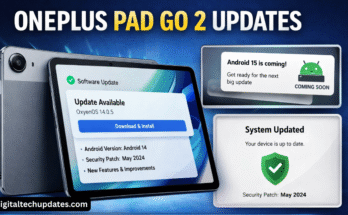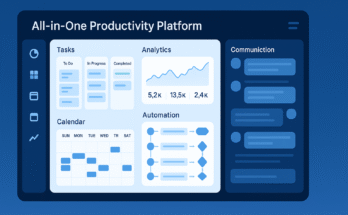A Windows emulator that you can run on your Internet browser allows you to run different versions of the operating system on the same computer, which can be useful in many ways.
Some of these emulators even work as virtual machines, allowing you to install and run a compatible program for testing purposes. Regardless of the need and purpose, you’ll be able to try the Windows operating system emulators we presented below on your Internet browsers.
Windows 95 Emulator
If you’re craving a slice of the 90s, Windows 95 in DOSBox Emulator will take you back to that time. You can run this “ancient” version in your browser, thanks to the DOSBox emulator, which compiles the source code of the Windows 95 disk image into JavaScript. The emulator loads the image into RAM and creates a virtual environment for you to interact with the operating system.
Once you load the emulator, you’ll be able to do a variety of things, including drawing in Paint and writing in WordPad. You can even play the built-in games that came with Windows 95, such as FreeCell, Hearts, Minesweeper, and Solitaire.
DOSBox is an x86 emulator with DOS, designed to run DOS games and applications. It doesn’t emulate Windows 95 natively, but it’s possible to run it inside DOSBox using a certain set of configurations and tools.
The process involves creating a virtual machine inside DOSBox and installing Windows 95 on that virtual machine. This isn’t a perfect solution, and emulation may not be as smooth as running Windows 95 on native hardware or using dedicated virtualization software like VirtualBox or VMware.
Below are the steps you need to follow to run Windows 95 in DOSBox:
- Installing DOSBox. Download and install DOSBox from the official website: https://www.dosbox.com/download.php
- Creating a virtual hard disk. Open DOSBox and use the following commands to create a virtual hard disk image: imgmake filename.img -t hd -size 500.
- Mount the virtual hard disk. Mount the virtual hard disk using the following command: imgmount 2 filename.img -size 512,63,16,625.
- Mount the Windows 95 ISO file. Mount the Windows 95 ISO file using the following command: mount d path\do\windows95.iso -t iso.
- Booting the Windows 95 installation disc. Change to the D: drive and run setup to start the Windows 95 installation: d: setup.exe.
After that, follow the steps to install Windows 95. Follow the on-screen instructions to install Windows 95 on the virtual hard disk.
Starting Windows 95:
- After the installation is complete, you can start Windows 95 by starting DOSBox and booting from the virtual hard disk.
The Windows 95 emulator will save the changes you make to your browser’s local storage, so you’ll be able to find any files you’ve created in a Windows 95 program, such as WordPad, on your desktop. But you won’t be able to do some things; you won’t be able to transfer files in and out of the emulator, or you won’t be able to access the Internet through Internet Explorer.
Windows 98 Virtual x86 Emulator
Windows 98 Virtual x86 offers a fully functional version of Windows 98 in a virtual environment. It’s an emulator that offers full access to programs, games and tools.
As you know, Windows 98 is Microsoft’s operating system that came out as a successor to Windows 95. It was part of the Windows 9x series of operating systems and was designed for personal computers. Windows 98 brought several improvements over its predecessor, including improved performance, support for USB devices, and the inclusion of Internet Explorer 4.0. The term “Virtual x86 Emulator” generally refers to software that emulates the x86 architecture, allowing you to run operating systems designed for x86-compatible processors on non-x86 hardware. In the context of Windows 98, a virtual x86 emulator can be virtualization software that allows you to run Windows 98 on a system that doesn’t have an x86 architecture.
Virtualization software, such as VMware, VirtualBox, or Microsoft Hyper-V, creates a virtual environment on a home system, allowing you to install and run guest operating systems within that virtual environment. These virtual machines can run a variety of operating systems, including Windows 98, as if they were running on their own dedicated hardware.
You can even browse the Internet through Internet Explorer through this emulator, but you may not be able to access some modern sites. Be sure to run the networking.bat file first if you want the emulator to access the Internet. You’ll find it on your desktop. On top of that, if you’re tech-savvy enough, you can install some compatible games and programs inside the emulator. This emulator allows you to load disk images from external storage devices. In addition, the emulator allows you to save the current state of the emulator, which your browser will download as BIN files. You can load them later and pick up where you left off.
Here’s how you can install this very interesting Windows 98 emulator:
- To get started, download and install VirtualBox: Obtain the Windows 98 installation ISO or setup files.
- Installation steps: Start VirtualBox on your computer.
This is how to create a new virtual machine:
- Click “New” to create a new virtual machine.
- Enter a name for your virtual machine (e.g., “Windows 98”).
- Select “Type”: Microsoft Windows.
- Select “Version”: Windows 98.
Allocate memory (RAM):
- Select the amount of RAM for your virtual machine (e.g., 512 MB).
Creating a virtual hard disk:
- Choose to create a virtual hard disk.
- Select the file type for the hard drive (usually VDI).
- Choose between dynamically allocated or fixed space (dynamic recommended).
- Allocate a size for the virtual hard disk (e.g., 2 GB).
Mounting the Windows 98 installation ISO file:
- Click on “Settings” for your virtual machine.
- Under “System”, move the CD/DVD option to the top of the boot order.
- Under “Storage”, click on the empty disk icon under the “Controller: IDE” section.
- Select the Windows 98 ISO file as the optical disc.
Starting the virtual machine:
- Click “Start” to start the virtual machine.
Installing Windows 98:
- The virtual machine will boot from the ISO.
- Follow the on-screen instructions to install Windows 98.
- After the installation is complete, remove the ISO from the virtual CD/DVD drive.
- Restart the virtual machine.
Installing VirtualBox Guest Additions:
- After Windows 98 is installed, go to the “Devices” menu in VirtualBox.
- Select “Insert CD with Guest Extras”.
- Run Setup from the CD image within Windows 98 to install the new add-ons.
Finishing the configuration:
Adjust your display settings, install additional drivers if needed, and configure your network within Windows 98.
Emulator for Windows XP: WinXP
With the WinXP emulator, you can get a fairly faithful recreation of the Windows XP user interface. Unfortunately, you won’t get full functionality because some programs and features don’t work. For example, although you can run Internet Explorer, you can’t access the Internet with it. But you can do some other things. For example, you can run different Windows XP menus. You can even run some programs, such as Paint and Winamp, and they’ll work as in the original operating system. Winamp, for example, will play music files, but here it should be remembered that these are preloaded files.
Follow these steps to install and start using the WinXP emulator:
- First of all, download and install VirtualBox.
- Get the Windows XP installation ISO or files.
Installation of WinXP emulator:
- Open VirtualBox and run the emulator on your computer.
How to create a new virtual machine:
- Click “New” to create a new virtual machine.
- Enter a name for your virtual machine (e.g., “Windows XP”).
- Select “Type”: Microsoft Windows.
- Select “Version”: Windows XP.
How to allocate working memory (or RAM):
- After that, select the working memory for your virtual machine (e.g., 1 GB or more).
Creating a virtual hard disk:
- Select yes to create a virtual hard disk immediately.
- After that, select the file type for the hard drive (usually VDI).
- Choose between dynamically allocated or fixed space (dynamic recommended).
- Allocate a size for the virtual hard disk (e.g., 20 GB or more).
Mounting the installation ISO file for Windows XP:
- Click on “Settings” for your virtual machine.
- Under “System”, move the CD/DVD option to the top of the boot order.
- Under “Storage”, click on the empty disk icon under the “Controller: IDE” section.
- Select the Windows XP ISO file as the optical disc.
Starting the virtual machine:
- Click “Start” to start the virtual machine.
- The virtual machine will boot from the ISO.
- Follow the on-screen instructions to install Windows XP.
Completing the installation process:
- After the installation is complete, remove the ISO from the virtual CD/DVD drive.
- Restart the virtual machine.
Installing additional plugins for VirtualBox:
- After Windows XP is installed, go to the “Devices” menu in VirtualBox.
- Select “Insert CD with Guest Extras”.
- Run Setup from the CD image within Windows XP to install new add-ons.
Emulator for Windows 7: Win7 Simu
Win7 Simu is an emulator of one of Microsoft’s most popular operating systems: Windows 7. With this emulator you can explore some features of the system and you can also run some applications and games. A number of programs are already installed in the emulator, including Google Chrome, Calculator, Notepad, Paint, and Command Prompt. They are functional and perform as proper as you’d expect. You can even save files you’ve created in Notepad and Paint.
Furthermore, you can access the Internet using Chrome and Internet Explorer. However, you need to download an extension that loads web pages using iframes. In short, iframes is a technology that embeds web pages within other parent web pages. Various popular games are pre-installed, including Mine Sweeper and Solitaire. But perhaps the most intriguing part for players is the inclusion of modern online games, such as Call of Duty: Mobile for PC – the best-selling first-person shooter video game of all time with 400 million copies sold, hugely popular for betting on highly-rated online gambling platforms at TopCasinoExpert.com with sportsbook/eSports sections, such as the best Ripple online casinos in 2024 – thanks to GameLoop. It’s the Windows-only app, specifically designed to provide PC gamers with a way to play mobile games on their computers. Apart from CoD, PC users will be able to play Flappy Bird, Among Us, Minecraft Survival, Zombs Royale, and many other games for which they feel nostalgic.
The Importance of Emulators
Emulators are platforms, either software or hardware, that let a computer system (or a mobile phone) act like another so the host can execute services and apps intended for the guest.
An emulator is a piece of software that mimics another device, or in certain rare circumstances, custom computer hardware. One solution that makes it possible to run Windows programs on Linux and Mac systems is called WINE. Dolphin is a program that lets you play games on a computer from the Nintendo GameCube and Wii.
The use of technology in computers and its benefits to various industries might help one understand why emulators are necessary. Usually, IT specialists use emulators for:
- System migration: Emulators allow software to run on one type of system and another. This is the first stage of system migration.
- Improving the systems they have at the moment: emulators, particularly in the embedded space, may provide many more debugging opportunities than hardware. They were utilized in MIMIC and other early minicomputers.
- Preserving outdated systems: emulators allow programs from out-of-date systems to execute on modern hardware.
- Developing around upcoming systems: Before the release of real hardware, emulators allow the construction of virtual computers and software debugging.
Of all the businesses, the gaming industry uses emulators the most. Applications known as emulators allow a computer or video game console to mimic another system. On contemporary desktop PCs and gaming consoles, they are frequently utilized to play games from the 1980s through the 2000s.
In the arts and media, emulators are indispensable. Since new media art relies on digital forms, emulation is necessary as a preservation approach. Artists can incorporate historical media with modern digital art and revive obsolete media technology in their creations by using emulators.




